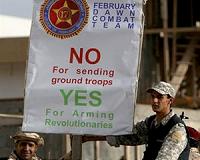| . |  |
. |
Tel Aviv, Israel (UPI) Apr 28, 2011 Israel's military is reported to have built a underground complex to train troops how to be Vietnam-style "tunnel rats" and go after Hezbollah in its elaborate bunker system across southern Lebanon should the shooting starts again. The Hebrew-language Maariv daily reported this week that two of its reporters and a camera crew were allowed to inspect the "subterranean city" built in northern Israel "to train for an imminent war" against Hezbollah. The newspaper quoted an unidentified "military commander" as saying the complex was fashioned on the labyrinth of tunnels constructed by the Viet Cong at Cu Chi, northeast of Saigon, during the Vietnam War. That complex of tunnels stretched for more than 100 miles 40 feet below the ground, on as many as three or four levels. They contained hospitals, arsenals, meeting rooms, sleeping quarters and kitchens. The objective of the Israeli training program is to fight Hezbollah in its hidden bunkers, where it deploys rocket launchers aimed at Israel and stores its weapons. The Israelis learned in the 34-day war it fought with Hezbollah in July and August 2006 that these concealed underground missile sites were impervious to airstrikes. After success in hitting missile sites in northeastern Lebanon during the opening hours of that conflict, Israeli forces were unable to stop Hezbollah from firing nearly 4,000 rockets into northern Israel, including the port city of Haifa. Since that war, in which Hezbollah's guerrillas fought the Israeli military to an embarrassing standstill, the Iranian-backed Shiite movement has constructed even more elaborate defense lines of bunker and tunnel complexes. This includes a countrywide fiber-optic communications system that cannot be electronically penetrated. In the 2006 fighting, highly agile teams of Hezbollah fighters were able to repeatedly ambush Israeli infantry and armored units in the south Lebanon panhandle, popping up from hidden bunkers and causing heavy casualties. "The Israeli military was only able to inflict a limited number of injuries to Hezbollah fighters when they emerged from their underground defenses," the commander told Maariv. Israel's military intelligence estimates that these days Hezbollah possesses more than 42,000 rockets and missiles supplied by Iran and Syria. These include hundreds of long-range missiles capable to hitting anywhere in Israel. Israel has developed the Iron Dome anti-rocket system. It made its combat debut in March against short-range Grad rockets fired by Palestinian militants in the Gaza Strip south of Israel. It shot down a dozen or so but only two batteries are operational and could easily be overwhelmed in large-scale missile attacks. The Israeli air force has been equipped with U.S.-made "bunker buster" precision bombs but the military believes that sending ground troops into Hezbollah's bunker network will be more effective in knocking out launch sites and depots. Hezbollah's arsenal of missiles and rockets is its most potent weapon because it exposes Israel's cities, industry and military bases to long-distance attack that to a large degree marginalizes Israel's vaunted ground forces. U.S. diplomatic cables released by WikiLeaks in recent months indicate that Israeli planners believe the next war with Hezbollah will last up to two months. During that time 24,000-36,000 rockets and missiles are expected to be unleashed against Israel -- an unprecedented assault. Some 6,000 of these will be aimed at the urban area around Tel Aviv, Israel's largest city, where at least 1 million people live. The casualty toll is expected to reach 3,500, with at last 100 civilian fatalities. The cables filed by the U.S. Embassy in November 2009 noted that Israeli military chiefs estimated Hezbollah would fire 400-600 rockets a day during the conflict, 100 of them aimed at Tel Aviv. In late March, the Israeli military released maps and satellite images of what is said were some 950 Hezbollah bunkers, missile sites and arms depots in south Lebanon, most of them hidden in or near 270 villages. A senior commander warned Hezbollah that if it fired into Israel, launch sites would be destroyed, even if they were in populated areas. Many of these sites are believed to have been identified by Israeli agents since the 2006 war. More than 150 alleged Israeli agents, an enormous number by any standards, have been arrested in Lebanon since 2009. Several have been sentenced to death.
Share This Article With Planet Earth
Related Links
 Italy bombs Libya, deepening rift with Berlusconi ally
Italy bombs Libya, deepening rift with Berlusconi allyRome (AFP) April 28, 2011 Italy's military took part in its first air raid over Libya Thursday in a deployment that triggered an uproar within Prime Minister Silvio Berlusconi's coalition partner, the Northern League. The pair of Tornado jets took off from the Italian island of Sicily equipped with precision-guided munition to strike "selected targets", a defence ministry official said without revealing details over ... read more |
|
| The content herein, unless otherwise known to be public domain, are Copyright 1995-2010 - SpaceDaily. AFP and UPI Wire Stories are copyright Agence France-Presse and United Press International. ESA Portal Reports are copyright European Space Agency. All NASA sourced material is public domain. Additional copyrights may apply in whole or part to other bona fide parties. Advertising does not imply endorsement,agreement or approval of any opinions, statements or information provided by SpaceDaily on any Web page published or hosted by SpaceDaily. Privacy Statement |